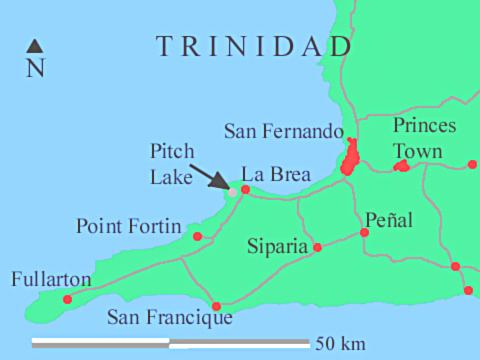 | ||
Similar Asa Wright Nature Centre, Emperor Valley Zoo, Maracas Beach, Queen's Park Savannah, Yerette | ||
Pitch lake la brea trinidad and tobago
The Pitch Lake is the largest natural deposit of asphalt in the world, at La Brea in southwest Trinidad, within the Siparia Regional Corporation. The lake covers about 40 ha and is reported to be 75 m deep.
Contents
- Pitch lake la brea trinidad and tobago
- La brea pitch lake in trinidad tobago by choco trini
- History
- Microbiology
- Geology
- References
Pitch Lake is a tourist attraction that attracts about 20,000 visitors annually. It is also mined for asphalt by Lake Asphalt of Trinidad and Tobago.
La brea pitch lake in trinidad tobago by choco trini
History
The Pitch Lake has fascinated Western explorers and scientists, as well as attracting tourists, since its discovery by Sir Walter Raleigh in his expedition there in 1595. (The native Indians knew about and showed it to him to help him caulk his boat). Raleigh himself found immediate use for the asphalt to caulk his ship. He referred to the pitch as "most excellent... It melteth not with the sun as the pitch of Norway". Since its re-discovery, there have been numerous research investigations into the use and chemical composition of this material. There have been countless theories, postulations, and conclusions as to the size, source, and origin of the asphalt.
In 1887, Amzi Barber, an American businessman known as "The Asphalt King", secured a 42-year monopoly concession from the British Government for the Pitch Lake for his company, Barber Asphalt Paving Co. It was from this source that many of the first asphalt roads of New York City, Washington D.C., and other Eastern U.S. cities were paved.
Microbiology
Evidence of an active microbiological ecosystem have been reported. Archaeal and bacterial community co-exists with novel species being discovered from Pitch Lake samples. Besides this, novel fungal life forms are described which can grow on the available asphaltenes as a sole carbon and energy source.
Geology
The origin of The Pitch Lake is related to deep faults in connection with subduction under the Caribbean Plate related to Barbados Arc. The lake has not been studied extensively, but it is believed that the lake is at the intersection of two faults, which allows oil from a deep deposit to be forced up. The lighter elements in the oil evaporate under the hot tropical sun, leaving behind the heavier asphalt. Bacterial action on the asphalt at low pressures creates petroleum in asphalt. The researchers indicated that extremophiles inhabited the asphalt lake in populations ranging between 106 to 107 cells/gram. The Pitch Lake is one of several natural asphalt lakes in the world. The La Brea Tar Pits (Los Angeles), McKittrick Tar Pits (McKittrick) and Carpinteria Tar Pits (Carpinteria) are all in the U.S. state of California. Lake Guanoco is in the Republic of Venezuela.
